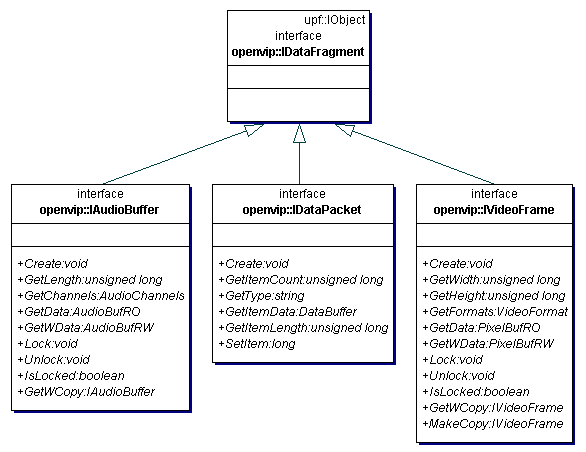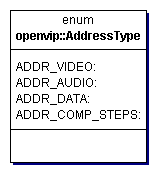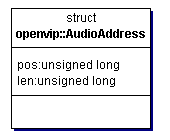We have already introduced the concept of networks, modules and connectors. To be able to understand how a module works, we need to learn about data types that the modules process. For example, to be able to connect different video filters in a single network it is necessary that they use a common video frame format.
The data types supported by OpenVIP core are all derived from a base
interface called IDataFragment:

The diagram shows that there are three derived interfaces:
IVideoFrame,
IAudioBuffer and
IDataPacket. The next sections briefly
introduce each of them. For a detailed description see the OpenVIP API
reference documentation.
The IVideoFrame interface provides a
way to create new video frames and to convert them between different
formats. The methods of IVideoFrame
interface are implemented in openvip.VideoFrame
class.
It is a common wisdom that an uncompressed digital image may be stored in formats such as RGB, RGBA, YUV etc. The RGB formats are widely used in still image files such as JPG, PNG. On the other hand, the YUV formats are common in video files such as AVI or MPEG due to the fact that they consume less memory than RGB. The modules in OpenVIP network might need to use both RGB and YUV formats: Where input plugins produce frames depending on the input file format, a RGB decomposition filter surely prefers to get an image in RGB format.
The solution is that a module can ask the
VideoFrame class to convert the frame in a
specified format. Moreover, the videoframe instance can hold the same
videoframe in different formats at the same time. A videoframe in specific
format is obtained using the GetData and
GetWData calls. One uses the former to get a
videoframe only for reading, while the latter returns data which can be
modified.
Apart from conversion, IVideoFrame
provides methods for creating new frames and for locking and unlocking a
frame (for the internal use of OpenVIP). A locked frame cannot be obtained
using the GetWData call; instead, you have to
make a copy of the frame using the GetWCopy
method.
The IAudioBuffer interface
encapsulates data and methods which are neccessary to store and retrieve
blocks of audio samples. These samples are always represented by 16-bit
signed integer values using the machine-specific endianity (although some
input modules read 8-bit samples, they convert them to 16-bit format). It
is possible to store more than one audio channel in a single audio buffer;
the samples for individual channels are then interleaved.
The only class which implements the
IAudioBuffer interface is called
openvip.AudioBuffer. It provides methods which are
similar to the IVideoFrame's methods -
creating empty audio buffers, accessing them in read-only or read-write
mode and locking the buffer.
The data packets contain data which are neither video frames nor audio samples. For example an input module which could read a file with subtitles can make them available to other modules by putting them into data packets. The graphical frontend to OpenVIP uses data packets to visualize audio tracks - this visualization module reads audio samples and returns some numerical values in form data packets.
To be able to recognize data packets of a certain type, packet contains a type identifier (string). Apart from this identifier a data packet can carry an arbitrary number of items. The items are accessed using their numbers and can contain arbitrary data.
The methods of IDataPacket interface
are implemented in openvip.DataPacket class. They
include the basic operations such as creating new packets, accessing
individual items and modifying their content.
It is often necessary to be able to identify the data a module is interested in. For example, the scheduler needs to identify the data a module should process at the moment. To fulfill this request, the module may ask the core for another piece of data and so on. There are different addressing schemes for different data types:

A video address (ADDR_VIDEO address type) is
simply a number identifying a particular video frame.
A block of audio (ADDR_AUDIO address type) is
determined by an AudioAddress structure, which
describes the audio block start (in samples from the beginning) and its
length (in samples, too):

The ADDR_DATA address type corresponds to a
group of data packets of a given type. It is represented using a
DataAddress structure, which contains the type
identifier and the time interval specification (its beginning and length
in seconds):

Finally, there are so-called computation step addresses (type
ADDR_COMP_STEP) which hold a single number
identifying the computation step. The concept of computation steps will be
explained in More on
modules.